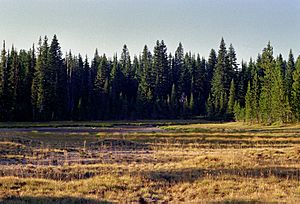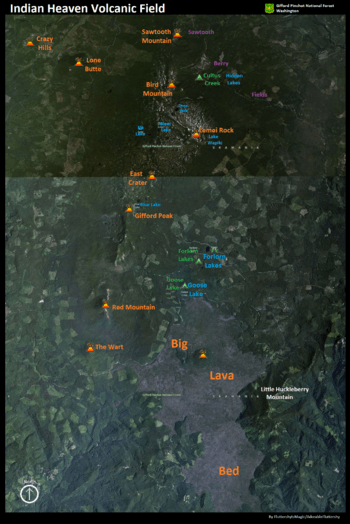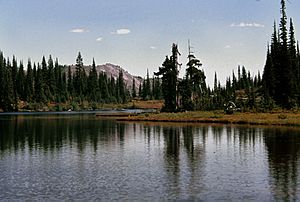Indian Heaven facts for kids
Quick facts for kids Indian Heaven |
|
|---|---|
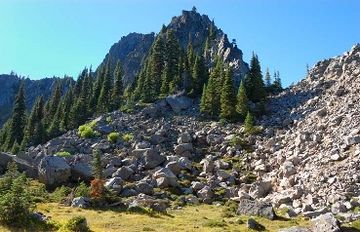
Lemei Rock in the Indian Heaven volcanic field
|
|
| Highest point | |
| Elevation | 5,925 ft (1,806 m) |
| Geography | |
| Parent range | Cascade Range |
| Geology | |
| Age of rock | Pleistocene and Holocene |
| Mountain type | volcanic field |
| Volcanic arc | Cascade Volcanic Arc |
| Last eruption | 6250 BCE |
| Climbing | |
| Easiest route | Lemei Trail, Indian Heaven Trail, with rock scrambling |
Indian Heaven is a volcanic field located in Skamania County, Washington, in the United States. It sits between two famous volcanoes, Mount St. Helens and Mount Adams. This area has been volcanically active for a very long time, from the Pleistocene (Ice Age) to the early Holocene epoch (our current time).
The field stretches from north to south and has six main shield volcanoes. These are wide, gently sloping volcanoes that look like a warrior's shield. On top of these shields, you can find smaller spatter and cinder cones. The area also has subglacial volcanoes and tuyas, which are volcanoes that erupted under ice. The highest point in Indian Heaven is Lemei Rock, standing at about 5,925 feet (1,806 meters) tall.
Indian Heaven has both polygenetic and monogenetic volcanoes. This means some volcanoes have erupted only once and then stopped, while others have erupted many times. There are about 50 places where eruptions have happened in the field, and about 40 different lava flows. Over the last 700,000 years, the field has produced a lot of volcanic rock.
The most recent big eruption happened about 9,000 years ago. It created a large cinder cone and a huge lava flow called Big Lava Bed. Even though it's been a long time, future eruptions are possible. However, the United States Geological Survey says the chance of a dangerous eruption from Indian Heaven is low.
The volcanic field is surrounded by the Indian Heaven Wilderness. This is a special protected area within the Gifford Pinchot National Forest. It's home to many different plants and animals. Native American groups have lived in this area for about 10,000 years. The name "Indian Heaven" comes from their original name for the place. Today, it's a popular spot for outdoor activities like hiking, fishing, and boating.
Contents
Where is Indian Heaven?
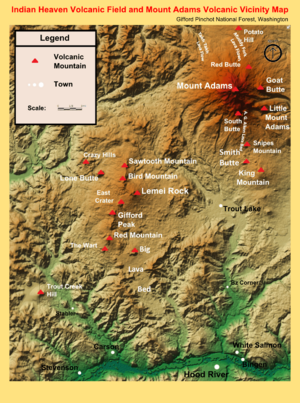
The Indian Heaven volcanic field is in Skamania County, Washington. It's part of the High Cascades, which is the eastern side of the Cascade Range. These mountains formed during the late Ice Age.
Indian Heaven is about 40 miles (64 km) east of Vancouver, Washington. It's also about 14 miles (23 km) north of the Columbia River. The field is located between Mount St. Helens and Mount Adams, about 19 miles (30 km) southwest of Mount Adams. The entire field is about 20 miles (32 km) across and covers an area of 175 square miles (453 square km).
The Indian Heaven Wilderness
The Indian Heaven Wilderness is a large protected area covering about 20,784 acres (84 square km). It's a high plateau with thick forests, subalpine meadows, and more than 150 lakes. The wilderness was created in 1984.
It sits between Mount Adams and the Columbia River Gorge. A famous long-distance trail, the Pacific Crest Trail, runs for 16.4 miles (26.4 km) through the wilderness from north to south. There are also seven other trails that connect, making a total of 42 miles (68 km) of trails. The area can be hard to reach because roads are often covered in snow until June. However, by mid-July, the snow usually melts, making it a great place to visit in the fall.
What Animals and Plants Live Here?
The forests in the Indian Heaven Wilderness are mostly made up of tall trees like Pacific silver fir, noble fir, and subalpine fir. You can also find Western red cedars, mountain hemlock, and Engelmann spruce.
Underneath the trees, there are many huckleberry plants and beargrass. In spring and summer, colorful wildflowers bloom. You might also see vine maples, blueberry bushes, and false hellebore. Many of the lakes are stocked with different types of trout, like cutthroat, rainbow, and brook trout.
The wilderness is home to amphibians like frogs. Larger animals include deer, elk, and American black bears. Be aware that there are many mosquitoes in the area, which is why some people jokingly call it "Insect Heaven"!
A Rich History with Native Americans
Indian Heaven and the surrounding wilderness have been important to local Native American tribes for about 10,000 years. The native peoples originally called this area Sahalee Tyee, which means "Indian Heaven."
The Sawtooth Berry Fields in this area are famous for their huckleberries. From 1902 to the mid-1920s, tribes like the Yakama, Klickitat, Wasco-Wishram, and Umatilla gathered here every summer. They came for annual huckleberry feasts, where they celebrated, traded, and performed rituals. They also raced horses, played games, made baskets, dried meat, and fished.
In 1932, the Yakama Nation and the United States Forest Service agreed to set aside part of the Berry Fields just for Native American use. Harvesting huckleberries is still a very important tradition today. You can still see marks from the "Race Track," a meadow used for horse racing, about 0.5 miles (0.8 km) off the Pacific Crest Trail. Some trees in the area even have scars where their bark was peeled to make baskets.
How the Volcanoes Formed
The Indian Heaven volcanic field is made up of several shield volcanoes that overlap each other. They form a line from Sawtooth Mountain in the north to Red Mountain in the south. There are also many cinder cones, lava flows, and spatter cones (small hills made of welded lava pieces).
About 50 different eruption spots exist in the field. These volcanoes were formed because of the subduction of the Juan de Fuca tectonic plate sliding under the North American tectonic plate. This process creates magma (molten rock) deep underground, which then rises to form volcanoes.
Most of the volcanoes in Indian Heaven are monogenetic, meaning they erupted only once before becoming inactive. The rest are polygenetic shield volcanoes, which erupted multiple times. About 80 percent of the lava from Indian Heaven is basalt, a dark, fine-grained volcanic rock. This field has produced more basalt than almost any other volcanic field in the Cascade Arc north of Newberry Volcano in Oregon.
The area has also been shaped by glaciers over time. At least four major periods of glaciation have occurred. For example, the Lone Butte tuya volcano erupted through a glacier that was about 770 feet (235 meters) thick!
Past Eruptions and Future Risks
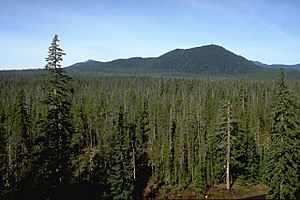
About 9,000 years ago, one of Indian Heaven's vents had a huge eruption. This created the Big Lava Bed, a large area of basaltic lava. This lava flow covered about 20 square miles (52 square km) and flowed south for about 10 miles (16 km) down the Little White Salmon River valley. It even came within 5 miles (8 km) of the Columbia River.
Many of the lava flows in Indian Heaven have lava tubes, which are natural tunnels formed by flowing lava. Some of these tubes extend as far as 29 miles (46 km) from where the lava erupted!
The volcanic field also has several subglacial volcanoes from the Ice Age. These volcanoes erupted under ice, creating flat-topped peaks called móbergs. For example, Crazy Hills and Lone Butte formed when lava interacted with ice or meltwater. Lone Butte erupted through a glacier, building its upper cone above the ice.
Volcanic activity in Indian Heaven has happened on and off for the past 700,000 years. This means it's possible that volcanoes in the field could erupt again in the future, producing more lava flows. However, the Volcano Hazards Program of the United States Geological Survey considers the volcanic threat level for Indian Heaven to be "Low/Very Low." This means the chance of a dangerous eruption is very small.
Scientists have studied the likelihood of lava flows covering areas around Indian Heaven. They estimate the chance of a specific spot being covered by lava is very low, somewhere between one in 100,000 to one in a million.
Main Volcanoes in Indian Heaven
The Global Volcanism Program lists several important volcanoes in the Indian Heaven field:
- Big Lava Bed pyroclastic cone: This is where the most recent eruption happened.
- Shield volcanoes: These include Bird Mountain, East Crater, Gifford Peak, Lemei Rock, Red Mountain, and Sawtooth Mountain.
- Tuya volcano: Lone Butte.
Red Mountain is the southernmost shield volcano, and Sawtooth Mountain is the northernmost.
| Name | Elevation | Location | |
| meters | feet | Coordinates | |
| Big Lava Bed | 1,278.6 | 4,195 | 45°32′N 121°27′W / 45.54°N 121.45°W |
| Bird Mountain | 1,739 | 5,705 | 46°12′N 121°28′W / 46.2°N 121.47°W |
| East Crater | 1,614 | 5,295 | 46°00′N 121°28′W / 46°N 121.47°W |
| Lemei Rock | 1,806 | 5,925 | 46°06′N 121°28′W / 46.1°N 121.46°W |
| Lone Butte | 1,457 | 4,780 | 46°18′N 121°31′W / 46.3°N 121.52°W |
| Red Mountain | 1,513 | 4,964 | 45°34′N 121°29′W / 45.56°N 121.49°W |
| Sawtooth Mountain | 1,632 | 5,354 | 46°24′N 121°28′W / 46.4°N 121.47°W |
Fun Things to Do
The Indian Heaven Wilderness is a great place for outdoor adventures! You can fish in its many lakes and ponds, go hiking, backpacking, or even ride horses. It's also a wonderful spot to watch wildlife.
A popular hiking route is the Indian Heaven loop, which is about 10 miles (16 km) long. It starts at the Cultus Creek campground and takes you through beautiful meadows and past lakes. The hike is generally not too difficult once you get past the first couple of miles.
The Lake Wapiki trail is another good option, about 9.6 miles (15.4 km) long. It climbs about 2,500 feet (762 meters) and offers amazing views of Mount Adams and Mount Rainier. The Blue Lake trail is 3.25 miles (5.23 km) long and can be combined with the Lemei Lake Trail for a 12.3-mile (19.8 km) loop. This moderate hike gives you views of lakes, ponds, meadows, and forests. It also leads to popular fishing lakes like Dee Lake, Heather Lake, Thomas Lake, and Eunice Lake. These lakes are also great for swimming, especially for families. Blue Lake is the deepest lake in the wilderness, at 46 feet (14 meters) deep, and was carved by glaciers.
One of the most popular places to camp is the Goose Lake Campground. It's a favorite for fishermen, boaters, and swimmers. The campground is run by the United States Forest Service and is usually open from July through October. There are also special camping spots near Thomas and Blue Lakes, designed to help protect the wilderness while still allowing visitors to enjoy the area.



